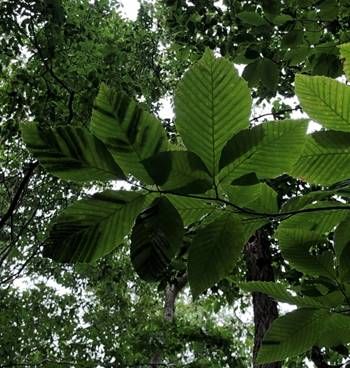DEM ASKS PUBLIC TO BE AWARE OF BEECH LEAF DISEASE

PROVIDENCE – The Department of Environmental Management (DEM) is asking Rhode Islanders to monitor their beech trees for signs of leaf damage from Beach Leaf Disease (BLD).
Early symptoms of BLD include dark striping on the tree’s leaves parallel to the leaf veins and are best seen by looking upward into the backlit canopy. The dark striping is caused by thickening of the leaf. Lighter, chlorotic striping may also occur.
Both fully mature and very young, emerging leaves show symptoms. Eventually the affected foliage withers, dries, and yellows. Drastic leaf loss occurs for heavily symptomatic leaves during the growing season and may appear as early as June, while asymptomatic and mildly symptomatic leaves show no or minimal leaf loss.
Bud and leaf production also are affected.
BLD was detected in the Ashaway area of Hopkinton, Rhode Island, in 2020 and in coastal Massachusetts. Before these findings, the disease was only known to be in Ohio, Pennsylvania, New York, and Connecticut.
The disease is caused by a nematode, a microscopic worm. While there are good species of nematodes, the BLD nematodes cause leaf damage that leads to tree decline and death. At this time, they are known to only affect American, European, and Oriental beech species.
Currently, there is no defined treatment for BLD as nematodes are difficult to control in the forest environment. Research is underway to identify possible treatments for landscape trees.
All ages and size of beech are affected, although the rate of decline can vary based on tree size. In larger trees, disease progression is slower, beginning in the lower branches of the tree and moving upward.
The disease also appears to spread faster between beech trees that are growing in clone clusters, as it can spread through their connected root systems. Most mortality occurs in saplings within two to five years. Where established, BLD mortality of sapling-sized trees can reach more than 90 percent.
Because of the seemingly random nature of disease in Rhode Island, DEM encourages homeowners and forest landowners to monitor their beech trees and report any suspected cases of BLD on DEM’s Invasive Species Sighting Report webpage.
Although BLD is relatively new in the US and information is limited, links to additional information about the disease and photos are posted on www.dem.ri.gov on the Division of Forest Environment’s Current Threats page. If people have further questions, they should contact a licensed arborist or email Nancy Stairs, forestry program supervisor in DEM’s Division of Forest Environment, via Nancy.Stairs@dem.ri.gov
For information on DEM programs, visit www.dem.ri.gov. Follow DEM on Twitter (@RhodeIslandDEM) or Facebook at www.facebook.com/RhodeIslandDEM for timely updates.
